- Introduction
- Factors Affecting Plant Growth
- What to Look for When Shopping for Indoor Plants
- Selecting Containers
- Pruning, Grooming, Cleaning and Repotting
- Pest Management
- What to Do for Plant Problems
- Summary of Cultural Care
- Bibliography
Introduction
Much of the scenic beauty of nature has been replaced by densely populated areas that sprawl for miles from urban centers. This visual pollution affects us all and leaves us with a longing for a closer connection with nature. We spend about 90 percent of our time indoors. Interior plants are an ideal way to create attractive and restful settings while enhancing our sense of well being. In addition, houseplants can be a satisfying hobby and can help purify the air in our homes. Indoor plants not only convert carbon dioxide to oxygen, but they also trap and absorb many pollutants. Many of these chemical compounds, which are released into our air through a process called “off-gassing,” come from everyday items present in our homes and offices.
To be a successful indoor gardener, you need to understand how the interior environment affects plant growth and how cultivation differs from growing plants outdoors.
Factors Affecting Plant Growth
Plant growth is affected by light, temperature, humidity, water, nutrition, and soil.
Light
Of all of the factors affecting plant growth in interiors, adequate light is by far the most important. Light is needed for plants to produce food and survive — generally, the more light available, the more food produced for growth. Light is measured in units called foot candles. One footcandle (ft-c) is the amount of light cast by a candle on a white surface 1 foot away in a completely dark room. Outdoors, the light levels on a bright day range from 10,000 ft-c in an open sunny area to 250 ft-c or less in the shade of a large tree.
It is very helpful to have a general idea of how much light is present in a given location in your house. You can get a fairly good estimate with a handheld light meter, or you can use a 35 mm camera and do the following:
- Set the film speed indicator to ASA 25 and the shutter speed to 1/60th second.
- Place a piece of white paper where you want to measure the light levels, aim the camera toward the paper close enough to fill the view, and adjust the f/stop so that the meter indicates a correct exposure.
- Read the approximate light level from Table 1.
| Table 1. Indoor light levels and appropriate f/stop settings | |
| f/stop Setting | Light Level |
| f/2 | 40 ft-c |
| f/2 | 75 ft-c |
| f/4 | 150 ft-c |
| f/5.6 | 300 ft-c |
| f/8 | 600 ft-c |
| f/11 | 1,200 ft-c |
| f/16 | 2,400 ft-c |
With the help of this table, you can obtain the light intensity reading from anywhere in your home. For example, if the f/stop setting is f/16, the approximate light level is 2,400 ft-c.
Using the light readings, your home can be divided into four areas, which have the following light levels for 8 hours per day:
- Low-light areas: 25 ft-c – 75 ft-c
- Medium-light areas: 75 ft-c – 200 ft-c
- High-light areas: over 200 ft-c but not direct sunlight
- Sunny light areas: at least 4 hours of direct sunlight
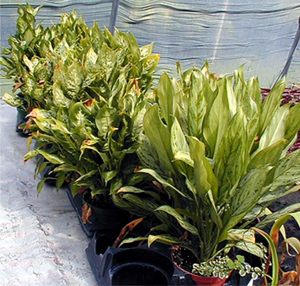 Figure 1. Many foliage plants are native to tropical rain forests, where light levels are low. These plants can be easily injured if exposed to strong light. Symptoms of over-exposure are upright leaves and bleached, scorched leaves. Do not place high-light sensitive plants in direct sunlight (on a porch or in front of a window). In this example, Chinese Evergreen (Aglaonema) and Dumb Cane (Dieffenbachia) show symptoms of high-light damage.
Figure 1. Many foliage plants are native to tropical rain forests, where light levels are low. These plants can be easily injured if exposed to strong light. Symptoms of over-exposure are upright leaves and bleached, scorched leaves. Do not place high-light sensitive plants in direct sunlight (on a porch or in front of a window). In this example, Chinese Evergreen (Aglaonema) and Dumb Cane (Dieffenbachia) show symptoms of high-light damage.In your home, the amount of light in a given location is variable — it is affected by the presence of trees outdoors (may shade at certain times), roof overhangs (may shade at certain times), wall color (reflectance), window curtains, day length, time of day, and time of year.
When shopping for indoor plants, select plants for a given location based on the approximate light levels in the spot. The plant’s label will usually contain information on the light requirements of the plant. If the plant label lists “high light” but the selected area in the home does not provide adequate light, artificial light sources such as fluorescent and/or special incandescent lights may be used to supplement the natural light.
Increasing the number of hours of light exposure can also help—for example, 16 hours of light and 8 hours of dark. This extends the number of hours during which plants receive light.
While adequate light is crucial for plant growth, too much light can be damaging (Figure 1).
Indoor plants are classified according to the amount of light needed for growth. (A list of plants and their light requirements is provided in Table 3.) Look for this information in general terms on the plant’s label:
- Low: minimum 25 ft-c – 75 ft-c, 75ft-c – 200 ft-c for good growth
- Medium: minimum 75 ft-c – 150 ft-c, 200 ft-c – 500 ft-c preferred
- High: minimum 150 ft-c – 1,000 ft-c, 500 ft-c – 1,000 ft-c preferred
- Very high: minimum 1,000 ft-c, 1,000+ ft-c preferred
Windows with eastern exposure within the home generally provide the best light and temperature conditions for most indoor plant growth because plants receive direct morning light from sunrise until nearly midday. Footcandle readings at these windows can reach 5,000-8,000. As the morning progresses, the direct sun recedes from the room.
An eastern room is cooler than southern or western rooms because the house absorbs less radiant heat. Light from the east is cooler than that from the south or the west, and thus it causes less water loss from the plants.
Windows with southern exposure give the largest variation of light and temperature conditions. The low winter sun shines across the room for most of the daylight hours.
In the summer, when the sun is farther north than it is in the winter, the sun rises at a sharp angle in the morning and is high in the sky by noon. Direct light comes into a south window only at midday. If there is a wide overhang covering the windows outside, the sun may not enter the room at all. The sun at noon on a summer day may measure 10,000 ft-c. Indoors, however, a southern window with wide eaves on the outside will receive about the same amount of light as a window with northern exposure. Southern and western exposures are interchangeable for most plants. In the winter, most plants, except those with definite preference for northern exposure, can be placed in a room with southern exposure.
Windows with northern exposure provide the least light and the lowest temperature. Because the United States is in the northern hemisphere, it receives most of its sunlight from the south. Out of the four exposures, the northern exposure receives the least light and heat year round.
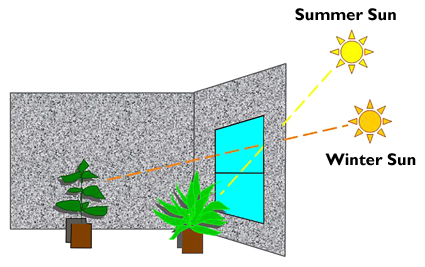 Figure 2. Within your home, changes in natural light penetration occur with the seasons.
Figure 2. Within your home, changes in natural light penetration occur with the seasons.Because of the low-light levels, maintaining healthy plants can be a challenge. A northern windowsill can measure light levels as low as 200 ft-c on a clear winter day, which is optimal for some plants, such as the African violet. This exposure is best for plants with green foliage because the coloration on variegated foliage tends to disappear under low-light conditions. Although most plants grown indoors will not grow in a northern room, they may tolerate it for short periods of time.
Seasons change the amount of natural light entering through windows. For example, the summer sun reaches a higher zenith compared to the winter sun (Figure 2). Therefore, sunlight penetrates farther into a room during winter.
How can you tell if your plant is not receiving adequate light?
- The plant does not grow.
- The internodes (spaces between the leaves) on the new growth are much longer than the internodes on the older part of the plant.
- The new leaves are smaller than the older leaves.
- The leaf color is a lighter green on the newer foliage than on the older foliage.
- The older leaves are dead.
Temperature
Temperature is the second most important factor influencing plant growth in interior environments. People feel comfortable in the range of 72 degrees F-82 degrees F, and interior plants can tolerate and grow well in the 58 degrees F-86 degrees F range because most indoor plants originate from tropical and subtropical areas of the world.
Temperature and light are linked through the processes of photosynthesis and respiration. These processes can be thought of as the “yin and yang” of plant life — two parts of a circle. Photosynthesis builds sugars and starch, which are then broken down by respiration to provide energy for the development of new tissues (growth) and the maintenance of existing ones. High temperature speeds up respiration. If the plant is not producing sufficient sugars (as under low light), then high temperatures may break down what little sugars are made, leaving little to none for growth. Maintenance takes precedence over growth; therefore, under insufficient light, plants do not grow. If light is so low that sugars produced are insufficient for maintenance, the plant eventually dies.
When sugar levels are low, the plant takes nutrients and sugars from older leaves to maintain new leaves. To help plants in an indoor environment, two options are available: (1) raise light levels to increase photosynthesis and sugar production or (2) reduce night temperature to lower respiration rates and allow more sugars for growth.
What temperatures are likely to occur in homes? During the summer, air conditioning that may have been turned off at night or weekend thermostat settings that may have been raised result in higher than desirable night temperatures. During the winter, heating that may have been turned off at night or weekend thermostat settings that may have been lowered may result in lower night temperatures. Be especially careful not to allow temperatures to drop below 50 degrees F, or chill damage will result on some sensitive foliage plants (e.g., Chinese Evergreen, Aglaonema). Chill damage is manifested with the yellowing of lower leaves and/or defoliation.
Plants vary in their minimum and maximum temperature requirements. Examples of cool-loving plants suitable for locations where temperatures drop to the low 50s at night and 60s during the day are Cyclamen, Wonder Plant, Fatshedera, Japanese Aralia, and Fatsia. A list of plants and their temperature requirements is provided in Table 3.
Not all interior plants have the same temperature requirements for optimal growth. For example, Cast Iron Plant, Aspidistra, and ferns actually grow better with cooler temperatures (72°F), while other tropical plants grow best if the temperatures are 90 degrees F – 95 degrees F. Such temperatures are rarely allowed indoors.
The best temperature range for indoor plants is 70 degrees F – 80 degrees F day and 65 degrees F – 70 degrees F night.
Relative Humidity
Relative humidity is the amount of moisture contained in the air. For interior plants, relative humidity below 20 percent is considered low, 40 percent – 50 percent is medium, and above 50 percent is high. Relative humidity is a very important factor, but it is easily overlooked. In a greenhouse, relative humidity is 50 percent or higher. Rapid transpiration and water loss may result when newly purchased plants are placed in the 10 percent – 20 percent relative humidity typical of most homes (Figure 3). Most indoor plants come from the tropics where high relative humidity is common. Therefore, take the following steps to help your plants adjust to the low relative humidity in your home.
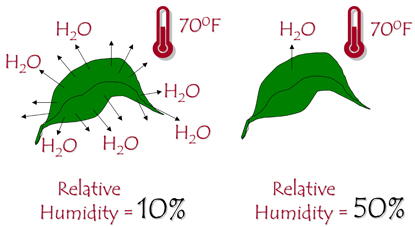 Figure 3a. The lower the humidity, the more water is lost from a leaf. At the same temperature of 70ºF, a leaf placed in 10% relative humidity loses more water compared with the leaf placed in 50% relative humidity.
Figure 3a. The lower the humidity, the more water is lost from a leaf. At the same temperature of 70ºF, a leaf placed in 10% relative humidity loses more water compared with the leaf placed in 50% relative humidity. Figure 3b. The higher the temperature, the more water vapor the air can hold, and the more water will be lost from the plant. At the same humidity of 50%, a leaf placed in 90ºF air loses more water compared with the leaf placed in 70ºF air.
Figure 3b. The higher the temperature, the more water vapor the air can hold, and the more water will be lost from the plant. At the same humidity of 50%, a leaf placed in 90ºF air loses more water compared with the leaf placed in 70ºF air.
- Place plants close together to create a microenvironment with a higher relative humidity.
- Use a shallow container filled with water and lava rocks or gravel, which will provide evaporation from a large surface area and increase relative humidity.
- Use a humidifier.
- Use mist bottles to spray water around the plant; however, in reality, you would need to mist every few minutes for an indefinite amount of time to make a difference in relative humidity around the plant.
- The foliage and flowers of plants with hairy leaves should not be sprayed with water. Water on such leaves may stay longer, providing opportunities for disease spores to germinate.
Water
Water Quantity
Learning to water is one of the most important skills in plant care. Applying too much water can suffocate plant roots and too little water causes growth to become erratic and stunted. Watering frequency will depend on the conditions under which the plants are growing. When dealing with how much water to apply, consider the following:
- Plant type: A list of plants and their moisture requirements is provided in Table 3. Not all plants are similar in their water requirements. This information, along with the light preference, is usually included on the plant label. For example, a croton, which prefers high light, will likely need more frequent watering compared with a succulent plant such as Opuntia cactus. Both have similar light needs but dissimilar water requirements.
- Plant size: Larger plants need more water compared to smaller plants.
- Container volume: If the growing container is too small, watering may be required more frequently.
- Soil moisture: The amount of water already present in the growing medium will also affect your watering frequency.
- Light intensity: Plants under high light transpire more water compared with plants under low light.
Improper watering causes many problems. Containers with saucers may cause an excessive build-up of soluble salts (from the applied fertilizer). High levels of soluble salts can cause damage to plant roots and a decline in growth. Discard any water that had drained in the saucer after irrigation, and apply large quantities of water to the soil to leach the accumulated soluble salts. In deciding when you should water, feel the soil by pushing a finger an inch or so below the surface. If the soil is still moist, no further water is needed. Water devices or water meters are also available to simplify watering.
Water Quality
The quality of the irrigation water is an issue with plants that are susceptible to fluorine and chlorine, such as Corn Plant (Dracaena), Ti Plant (Cordyline), Peacock Plant (Maranta), and Rattlesnake Plant (Calathea) (Figure 4). Alleviate this problem by letting the water stand for several days — so that some chlorine and fluorine will be released from it — before applying the water to the plants. Move susceptible plants away from the edge of the pool to prevent water splashes from reaching the foliage. Do not use susceptible plants around enclosed pools. In general, plants with long linear leaves (such as the Spider Plant) are more susceptible to fluorine.
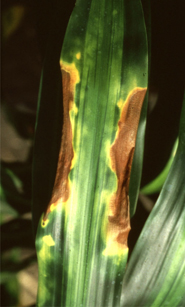 Figure 4a. Symptoms of fluorine damage on the Corn Plant include tip and leaf scorching.
Figure 4a. Symptoms of fluorine damage on the Corn Plant include tip and leaf scorching.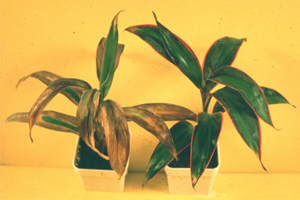 Figure 4b. Symptoms of fluorine damage on the Ti Plant include tip and leaf scorching.
Figure 4b. Symptoms of fluorine damage on the Ti Plant include tip and leaf scorching.
Nutrition
Many indoor gardeners have the same problem with fertilizer that they have with water — they want to give their plants too much. Danger from over-fertilization occurs because any fertilizer used, whether in liquid, powder, or tablet form, will dissolve in soil water and will form salts in the water. When you over-fertilize, the water in the soil becomes so salty that it “burns” the plant’s roots by removing water from them (Figure 5). Excess soluble salts accumulate as a whitish crust on the surface of the growing medium and/or near the rim of the container.
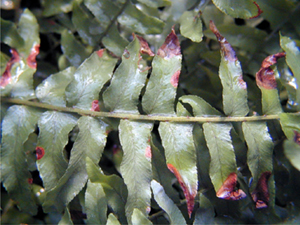 Figure 5a. Soluble salt burn is manifested as leaf marginal and tip burn. Dead roots also invite root diseases.
Figure 5a. Soluble salt burn is manifested as leaf marginal and tip burn. Dead roots also invite root diseases.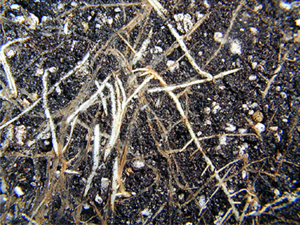 Figure 5b. Soluble salts can burn roots; notice that the healthy roots are white, while the dead roots are brown. Dead roots also invite root diseases.
Figure 5b. Soluble salts can burn roots; notice that the healthy roots are white, while the dead roots are brown. Dead roots also invite root diseases.Before feeding plants, consider the following:
Plant type: Some plants are heavy feeders (e.g., Ficus species), while others need little or no additional fertilizer for months (e.g., succulents).
Volume of soil: The growing medium that is present — smaller pots require less fertilizer compared with larger pots because they contain less soil.
Light intensity: The higher the light levels, the more nutrients needed for plant growth.
A newly purchased, healthy plant rarely needs an immediate application of fertilizer. In most cases, the amount of fertilizer applied by the commercial producer will supply enough nutrients for two to three months in the home. This rule is flexible — if deficiency symptoms are evident, fertilizer application is desirable.
The secret to fertilizing plants indoors is to apply small amounts of fertilizer as the plant grows. Without new growth, the plant has a limited need for more fertilizer. During the winter when light levels are low, a plant’s need for fertilizer reduces. During the summer when light levels increase and the plant is actively growing, its need for fertilizer increases. As a starting point, use about one-fourth the label rate for monthly applications. If the overall plant color becomes lighter green, fertilize every two weeks. If the new growth is dark green but the leaves are small and internodes seem longer than on the older growth, decrease the fertilizer rate.
Varying fertilizer formulations are available to the indoor gardener. Many fertilizers come in specially designed formulas for indoor plants. Generally, they contain a lower percentage of the required mineral elements to prevent over-fertilization problems.
Soil/Growing Medium
The growing medium provides anchorage, water, and minerals. When repotting plants, make sure that the new mix is well drained and aerated, holds water and nutrients well, and is within the right pH range (5.0-6.5). A good potting mix provides ample amounts of oxygen to the root system. Most professional mixes are good to use. Some plants require special mixes, e.g., bromeliads, orchids, and African violets. Either purchase these mixes or prepare your own. Below are some formulas that can be used to prepare a homemade potting mix.
Growing Mix for Flowering House Plants
The following potting mix will grow acceptable flowering plants in most homes for most gardeners:
- 1 part garden loam or potting soil
- 1 part sand or perlite or vermiculite
- 1 part peat moss
Add 2 to 3 ounces of 20 percent superphosphate and ¾ ounce of either bonemeal or dolomitic limestone (by weight) to 4 gallons of potting mix. After sterilizing the soil (see “How to Sterilize Soil”), add 3 tablespoons of a 6-6-6 or similarly balanced fertilizer to every 4 gallons (½ bushel) of mix. Add a minor element formulation according to the manufacturer’s recommendations.
Growing Mixes for Foliage Plants
Although most foliage plants will grow satisfactorily in the growing mix recommended for flowering house plants, they will grow better if the mix contains a higher percentage of organic matter.
- 1 part garden loam or potting soil
- 1 part sand or 2 parts peat moss
OR
- 1 part pine bark
- 2 parts peatmoss
OR
- 1 part sand
- 1 part pine bark
- 1 part peat moss
Add 2 to 3 ounces (dry weight) of dolomitic limestone to 4 gallons (½ bushel) of mix. For fluoride-sensitive plants, adjust the pH so it is no lower than pH 6.5. Superphosphate contains enough fluoride to cause foliar burn on sensitive plants. After sterilizing the soil, add 3 tablespoons of a 6-6-6 or another fertilizer such as 5-10-5 to each ½ bushel. Plastic-coated fertilizers also can be used; most of them require about 2 ounces per ½ bushel. Add a minor element formulation to the potting mix per the manufacturer’s recommendation.
Growing Mixes for Bromeliads
Bromeliads are plants from Central and South America, which are either epiphytic (they grow on tree branches or in the crotches of trees) or terrestrial (they grow in the ground). Although most of the bromeliads can be grown successfully in foliage plant mixes, most grow better in specially designed soil mixes. Any mix for bromeliads must be well aerated and drained.
- 2 parts peat moss
- 1 part perlite
- 1 part fir bark
OR
- 1 part peat
- 1 part pine bark
OR
- 1 part peat
- 1 part pine bark
- 1 part cypress shavings
Add 2 ounces of dolomitic limestone to 4 gallons (½ bushel) of soil mix and a minor element mix. Dissolve 1 ounce of 10-10-10 water-soluble fertilizer in 3 gallons of water. Use this solution after repotting and again monthly when watering. Also, add enough water to fill the vase formed by the overlapping leaf bases.
Growing Mixes for Orchids
Orchids have a great deal in common with bromeliads because they also grow on trees as epiphytes and on the ground as terrestrials. A mix for orchids should have excellent drainage and aeration, too. Some soil mixes that can be used are:
- 3 parts osmunda tree fern fiber (moisten before use by soaking in water for 12 hours)
- 1 part redwood bark
OR
- 5 parts fir bark
- 1 part perlite
Tree fern slabs may also be used to grow epiphytic orchids.Add 1 ounce (dry weight) of dolomitic limestone per 4 gallons (½ bushel) of soil mix. Do not add fertilizer to the mix. After the plants are potted, add ¼ ounce of liquid 10-10-10 with minor elements per gallon of water and fertilize once every 6 weeks (if the plants are growing in osmunda fern fibers). If plants are growing in fir bark, use a liquid 30-10-10 with minor elements every 6 weeks instead of a 10-10-10 fertilizer.
Growing Mix for Succulents and Cacti
Cacti and other succulents grow best in a well-drained and aerated soil.
- 2 parts garden loam or potting soil
- 2 parts sand
- 2 parts peat
- 1 part perlite (crushed charcoal can be substituted)
Add 2 ounces (dry weight) of dolomitic limestone to 4 gallons (½ bushel) of soil mix, 2 ounces (by weight) of bonemeal, and ½ ounce of superphosphate. After sterilizing the soil, add a minor element supplement according to the manufacturer’s recommendation.
Growing Mix for Ferns
Ferns grow well in most recommended mixes that have a high proportion of organic matter with good soil aeration and drainage characteristics. Use any of the suggested foliage plant mixes. However, most ferns kept indoors grow better in the following mix:
- 1 part garden loam or potting soil
- 1 part peat moss
- 1 part pine bark
- 1 part coarse sand
Add 2 ounces (dry weight) of dolomitic limestone to each ½ bushel (4 gallons) of soil mix and ½ ounce of either bonemeal or 20 percent superphosphate. After pasteurizing the soil mix, add minor elements to the mix. Add 1 tablespoon of a 6-6-6 or similarly balanced fertilizer to each ½ bushel of soil mix.
Growing Mix for African Violets
Any number of soil mixes for African violets exist, and most of them will grow high quality plants. A good mix should be well drained and aerated.
- 2 parts peat moss
- 1 part vermiculite
- 1 part perlite
Add 2½ tablespoons of dolomite and 1½ tablespoons of 20 percent superphosphate to each ½ bushel of soil mix. Add 3 tablespoons of a high phosphorous fertilizer such as 5-10-5 or a similar ratio of fertilizer.
How to Sterilize Soil
Sterilization reduces the number of diseased organisms and weeds present in the soil. First, mix the soil with an equal portion of vermiculite or peat moss (otherwise, the soil will become very hard). Next, moisten the mixture and place it in the oven. Allow it to “bake” at 180 degrees F–200 degrees F for 1 hour. Once the soil cools, it is ready to use. To treat soil in the microwave, first mix the portion with an equal amount of vermiculite or peat moss and moisten. Place the mixture in a plastic bag. Next, consult the manufacturer’s manual to determine the amount of time and power level needed to heat the quantity of soil to about 180 degrees F (most portions of soil will generally require about 10 to 15 minutes). Insert a probe into the soil and make sure it has heated to 180 degrees F – 200 degrees F. Allow the soil to cool before using it or storing it for future use.
Make sure that the soil or potting mix you want to sterilize does not contain perlite. At high temperatures, toxic levels of fluoride may be released and subsequently damage your plants.
Acclimatization
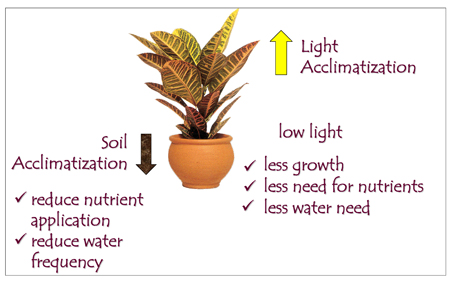 Figure 6. The two sides of acclimatization — the above-ground (light acclimatization) involves adaptation to low light, which means less growth and less need for nutrients. The below-ground (soil acclimatization) involves reduction of nutrients and water.
Figure 6. The two sides of acclimatization — the above-ground (light acclimatization) involves adaptation to low light, which means less growth and less need for nutrients. The below-ground (soil acclimatization) involves reduction of nutrients and water.Acclimatization is the adaptation of a plant to a new environment, and it is very important for the health and growth of indoor plants. In greenhouses, plants are accustomed to high light, nutrition, water supply, temperatures, and relative humidity — conditions ideal for fast growth (Figure 6). Residential homes, with low-light interiors and low relative humidity, will most likely produce a stressful experience for plants — the greater the difference between the previous environment and the environment of the house, the greater the stress the plant endures.
Acclimatization is generally done in the greenhouse or the nursery. Plants are grown for a period of time under low-light levels and with fewer nutrients. Because this slows down plant growth, acclimatized plants are not ready for the market as early as nonacclimatized plants. Acclimatized plants cost more compared to nonacclimatized plants, but this is money well spent. Figure 7 and Table 2 describe the symptoms and appearance of acclimatized plants.
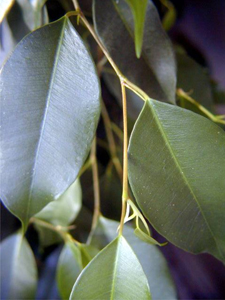 Figure 7. Acclimatized Weeping Fig; notice the large, dark green leaves and the elongated internodes.
Figure 7. Acclimatized Weeping Fig; notice the large, dark green leaves and the elongated internodes.To acclimatize plants at home, place newly purchased plants in bright areas for at least 3 to 4 weeks and then move them to their final location. Porches and patios are ideal bright places for your plants in the warm months, as long as the plants are not in direct sunlight. The most common symptom occurring in plants placed indoors is defoliation. As long as it is not extensive and it slows down after a few weeks, the plants will adjust to the particular location. Keep in mind, however, that each time the plant is moved around, it will experience an acclimatization period, and such changes may become evident.
Learn as much as possible about the extent of acclimatization of the chosen plants. The retailer should be able to provide this information. When shopping for plants at a garden center, ask if the plants have been acclimatized.
Remember that the most important factors of indoor plant growth are adequate light, fertilizer, and water at reduced rates.
| Table 2. Symptoms of acclimatized plants vs. nonacclimatized plants | |
| Acclimatized Plants | Nonacclimatized Plants |
| Medium to dark green leaves Large leaves Flat leaves Thin leaves Widely spaced leaves |
Yellowish to light green leaves Small leaves Partially folder leaves Thick leaves Closely spaced leaves |
| Long internodes Thin to medium stems Horizontal or slightly flexed leaf position |
Short internodes Thick stems Upright leaf position |
| Few new leaves Wide branch angles |
Many new leaves Acute angles |
What to Look for When Shopping for Indoor Plants
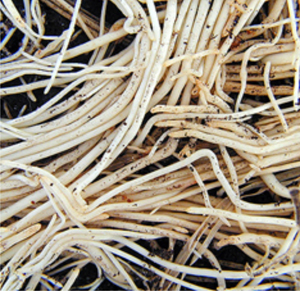 Figure 8. Healthy roots are typically white without any discolorations.
Figure 8. Healthy roots are typically white without any discolorations.Purchase only healthy looking plants with medium to dark green foliage (unless foliage is supposed to be a different color).
Avoid plants with unnaturally spotted, yellow, or brown leaves. If the plant is unhealthy at the nursery, chances are that it will die soon after consumer purchase. Look for pests on the undersides of leaves. Remove the plant from the pot and examine the root system. Healthy roots generally are and should be visible along the outside of the soil ball and should have an earthy smell (Figure 8).
Any discolorations, generally brown or blackened roots, are signs of problems. Some plants, such as Dracaenas, have roots with colors other than white. Unhealthy roots also may smell foul. If shopping for ferns, do not be alarmed if you see brown-colored spots or long rows of structures on the lower leaf surface; these “spots” are reproductive structures called spores.
Selecting Containers
Planters can enhance the decorative value of the plants. Consider the following when selecting a planter:
- Suitability for the plant’s needs
- Suitability for the needs of the individual and the environment
- Cost and availability
- Strength and durability
- Drainage
- Weight
The style, shape, and size of the container should complement the plants grown. Small containers are best for small slow-growing plants, while fast-growing plants are better suited for large containers.
Containers can be made from a wide range of materials — terra cotta, clay, plastic, or ceramic. Terra cotta pots, made of fired clay, are some of the most popular choices, with designs ranging from plain to ornate. Plants perform very well in terra cotta pots, as the porous surface allows good air exchange between the plant roots and the environment. Other clay containers (not considered terra cotta) range from gray to brown in color, depending on the clay used. Clay pots can be glazed or unglazed. The glazed pots restrict air exchange but offer more design choices. Unglazed pots evaporate water faster and plants in them may need more frequent watering. Disadvantages of clay containers include their weight (especially large pots) and the chance they will chip or break.
Constructed of materials such as polyethylene, polyurethane, recycled plastic, and fiberglass, plastic pots have evolved from very simple to quite elaborate. They have the advantage of being lightweight as well as chip- and break-resistant. Air exchange and water evaporation rates are generally lower in plastic containers compared with clay containers. Plants in plastic pots will not dry out as quickly as plants in clay pots, increasing the danger of over-watering.
In general, there are two types of containers — ones with drainage holes and ones without. Do not allow plants in containers with drainage holes to sit in saucers filled with water, unless the plant is suspended above the water level by a layer of rocks. To avoid salt buildup, leach the soil once a month by applying a gallon of water to every cubic foot of potting medium; after a few hours, follow with ½ gallon of water. If the potting medium contains garden soil, apply 5 gallons of water per every cubic foot of growing medium.
Containers without drainage holes work well for plants such as the Peace Lily (Spathiphyllum), which needs plenty of water, but they should not be used for cacti and succulents.
Pruning, Grooming, Cleaning, and Repotting
When is the best time to prune? “When the knife is sharp” goes the old saying, and it means using the natural life cycles as a guide. For example, when the plant is growing rapidly and you want to maintain a certain size, prune lightly and frequently, removing shoots or shoot tips when they are small. When removing the very immature tips, the practice is known as pinching. Pinching and light pruning also increase branching of the stem and result in a stockier, fuller plant.
When the plant has outgrown its container, root pruning is advisable. Pull roots away from the root mass then cut them back to within 1 inch of the soil mass. An alternative method is to make three or four vertical cuts 1 inch deep in the soil ball on the opposite sides of the root ball.
If you are re-using containers, make sure that they are clean by washing out any old compost, chemical, or paint residues. Sterilize the container by placing it in a 10 percent bleach solution and rinse well.
A clean plant is a healthy plant. Water flow causes salt accumulation along the leaf margins and/or tips, creating necrotic areas. Dust dulls normal leaf coloration, lessening plant value, but it also shades plant surfaces, reflecting light that can be used in photosynthesis. Dust on lower leaf surfaces may clog stomata (specialized cells involved in water transpiration), inhibiting gas exchange within the leaf. Leaves with thick, shiny cuticles (Croton, Ficus, Peace Lily, Bromeliads) should be cleaned with a damp sponge.
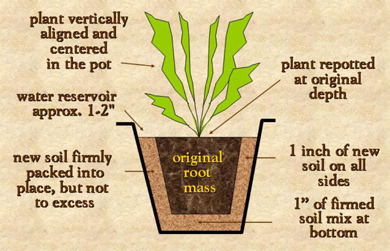 Figure 9. Properly repotted plant.
Figure 9. Properly repotted plant.If the plant is small, dip the foliage in tepid water and swirl it around. Water should not be used when cleaning cacti, African violet leaves, and other plants with hairy leaves. Instead, use a clean, small paintbrush brush to remove dust. Remove dead flowers and leaves regularly. Leaves with tip and/or marginal necrosis, such as fluoride damage, should be trimmed to the healthy part.
If the plant has been growing well, it will likely need repotting. The decision to repot should be based on plant appearance—if it is top-heavy, if it fills the container with new shoots, or if it has extensive root growth out of the pot’s drainage holes. Ideally, plants should be repotted in 1 inch increments. Planting into too large a container will give the roots more soil than they initially need. The excess soil will hold extra moisture, creating overly wet conditions. Increase pot size through smaller increments rather than doubling the pot size in one step (Figure 9).
Pest Management
 Figure 10. Various scales.
Figure 10. Various scales.Very few plants stay pest-free forever. Pest insects are more likely to be encountered on indoor plants than diseases because the interior environment rarely offers favorable conditions for foliar diseases to develop. However, when plants are grown under stressful conditions (such as low light and excess water), soil-borne pathogens often develop.
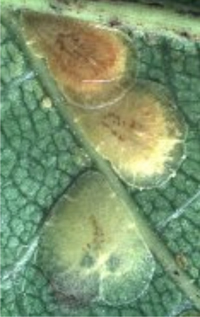 Figure 11. Various scales.
Figure 11. Various scales.Scales are ⅛ inch to ⅓ inch long with various colors, depending upon the species. The three main families of scales are armored (the body covering can be separated from the body), soft (the body covering cannot be separated from the body), and mealybugs. Scales suck plant juices from leaves and stems, causing stunting, leaf discoloration, and death of the tissue. As a result of their feeding, sticky “honeydew” (digested plant sap) is excreted (the exception is armored scales). Honeydew offers a growing medium for a fungus called sooty mold, which, when present, can detract from the plant appearance and block light from reaching the leaf surface. Scales are usually inconspicuous; by the time infestation is noticed, the population is usually very large (Figure 10 and Figure 11).
Mealybugs are soft bodied, 1/5 inch to 1/3 inch long, and covered by white, waxy filaments, giving them a white, cottony appearance. Insects are frequently found on the new growth at the stem apex, where they suck plant juices, causing leaf wilting and abscission (Figure 12). Some species of mealybugs appear first on the undersides of leaves. Mealybugs excrete sticky honeydew, which attracts sooty mold.
 Figure 12. Mealybugs are the major pest problem for houseplants.
Figure 12. Mealybugs are the major pest problem for houseplants.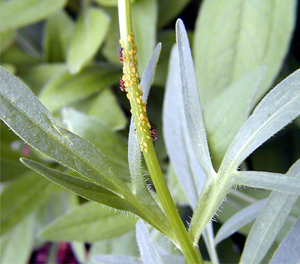 Figure 13. Aphids.
Figure 13. Aphids.
Aphids are soft bodied, pear shaped, 1/25 inch to 1/8 inch long, and are usually green in color (but may be pink, blue, brown, yellow, or black). Aphids reside on new growth or on the underside of young leaves, where they suck plant juices, causing deformed, curled growth of new leaves, buds, and flowers. Aphids also excrete honeydew. Aphids are usually wingless but develop winged forms when colonies become too large (Figure 13).
Spider mites are the second most common pest problem on houseplants (Figure 14). The adult females are about 1/50 inch long, hardly visible with the unaided eye. Mites feed on the undersides of young leaves. Infected areas are grayish or yellow speckled.
Webs form as a means of dispersal. Spider mites thrive in hot and dry conditions.
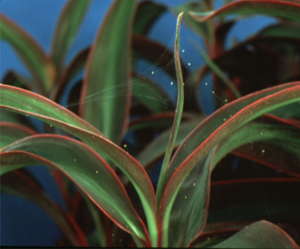 Figure 14. Spider mites with webbing.
Figure 14. Spider mites with webbing.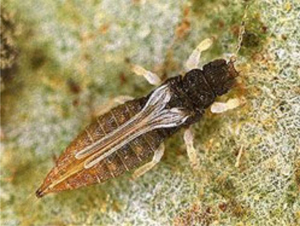 Figure 15. Thrips.
Figure 15. Thrips.
Thrips, while uncommon on houseplants, predominantly feed on plants in patios and other outdoor areas (Figure 15). Thrips are small, slender, 1/25 inch to 1/12 inch long, and tan, black, or brown in color, with lighter markings. Adults and larvae feed on shoot tips, flowers, and leaves by sucking sap and cell contents. Injured tissue has a whitish or silver-flecked appearance due to the light reflecting from the empty cell walls of the dead cells.
What to Do for Plant Problems
Pests
- The best method is prevention — purchase pest-free plants.
- Remove a light infestation of mealybugs or aphids with a cotton swab dipped in rubbing alcohol.
- If outdoor conditions permit, take the affected houseplant outside in a protected area, where natural predators will eventually come and rid the plant of the pest.
- Treat with insecticidal soap. The best results occur on plants that have been hardened off in the interior environment. New plants, if they have not been acclimatized (accustomed to lower light, fertilizer, and water levels), are going to be tender and should be treated after the first couple of weeks. Add 2 teaspoons of insecticidal soap per gallon of water and wipe foliage and stems with the soapy water and soft cloth.
- Heavy infestations may be too extensive to treat. Discard these plants and do not place them in your compost pile.
- Do not introduce beneficial insects indoors! They may work great in the greenhouse with a large number of plants and pests, but there is just not enough food in your home to sustain their population. Most pests can be controlled culturally on indoor plants without the use of chemicals.
Another potential problem in the indoor garden is the occurrence of various diseases. For a disease to happen, three factors must be present: (1) a susceptible plant, (2) a viable pathogen, and (3) a favorable environment. Because the home has very low relative humidity and water is often applied directly to the growing medium (thus keeping the foliage dry), chances of a foliar disease occurring are minimal.
Leaf spots are the most common problem, but they are usually not caused by a disease. For example, leaf scalds occur when water droplets on the leaves act as lenses and focus excessive light in one spot, bleaching the chlorophyll and killing the underlying tissue. Spots with patterns are signs of a disease, including a tan center, dark borders, and/or light-colored borders called “halos.” Dark structures may be present on the underside; these contain a means of dispersal called spores.
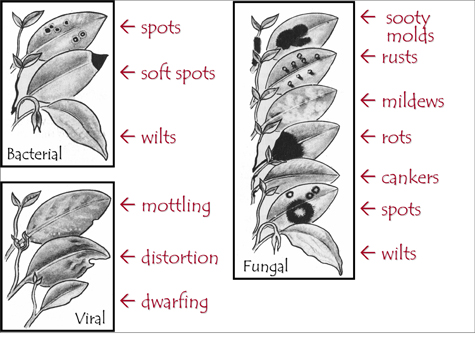 Figure 16. Bacterial diseases cause spots, soft spots, and wilts. The signs of a fungal disease are sooty molds, rusts, mildews, rots, cankers, spots, and wilts. Viral diseases cause mottling, distortion, and dwarfing.
Figure 16. Bacterial diseases cause spots, soft spots, and wilts. The signs of a fungal disease are sooty molds, rusts, mildews, rots, cankers, spots, and wilts. Viral diseases cause mottling, distortion, and dwarfing.Most importantly, avoid causing stress to plants. A healthy plant is much more likely to fight off a disease than a stressed one. Use a simplified key for identifying the causal agent for a disease (Figure 16).
Soil-borne pathogens are commonly found on stressed plants. Soil-borne pathogens affect plants at or below the soil line; disease development is usually well underway before symptoms are noted on plant parts aboveground. Soil-borne diseases commonly occur when the growing medium is kept excessively moist and fertility levels are high. Low light and over-watering create favorable environments for soil-borne diseases indoors.
The most common causes of stress in interiors are low light and over-watering.
Summary of Cultural Care
Table 3 provides a listing of more than 200 plants and their cultural requirements. To summarize cultural care guidelines, the following abbreviations and coding numbers are used. These guidelines apply to actively growing indoor plants.
L = Light
- Sunny light areas: At least 4 hours of direct sun
- High-light areas: Over 200 ft-c, but not direct sun
- Medium-light areas: 75 ft-c to 200 ft-c
- Low-light areas: 25 ft-c to 75 ft-c
T = Temperature
- Cool: 50°F night, 65°F day temperatures
- Average: 65°F night, 75°F day temperatures
- Warm: 70°F night, 85°F day temperatures
H = Relative Humidity
- High: 50% or higher
- Average: 25% to 49%
- Low: 5% to 24%
W = Watering
- Keep soil mix moist
- Surface of soil mix should dry before re-watering
- Soil mix can become moderately dry before re-watering
S = Suggested Soil Mix
For specific ingredients, refer to the various growing mixes in “Soil/Growing Medium.” The soil mixes are keyed as follows:
- Flowering house plants
- Foliage plants
- Bromeliads
- Orchids
- Succulents and cacti
- Ferns
- African violets and other Gesneriads
Bibliography
Manaker, G. H. (1997). Interior plantscapes: Installation, maintenance, and management (3rd ed.). Prentice Hall.
McConnell, D. B. (1978). The indoor gardener’s companion: A definitive, color-illustrated guide to the selection and care of houseplants. Van Nostrand Reinhold Company.
Status and Revision History
Published on Dec 15, 2006
Published on Oct 13, 2009
Published with Full Review on Dec 01, 2012
Published with Full Review on Jan 05, 2017
Published with Full Review on May 27, 2020
Published with Full Review on Jul 21, 2022


























































